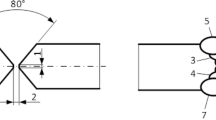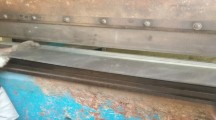Abstract
Three-point bending tests were conducted at various low temperatures to obtain the crack-tip opening displacement (CTOD) values of three varieties of structural steels with several plate thicknesses. Parameters of the crack growth resistance curve (Rcurve) of each specimen were calibrated by regression of the test data points (CTOD versus crack extension). The temperature and the plate thickness had great effects on the R-curve shape (flat or rising) and the fracture mode (brittle or ductile). In a design process of a steel component, an initial crack is assumed according to its fatigue category. Through the analyses of the crack driving force and the resistance, a practical method is proposed for fracture resistant design and evaluation of flawless or flawed steel components at low temperature.
Similar content being viewed by others
References
AASHTO LRFD (2004). AASHTO LRFD Bridge design specifications. 3rd ed., American Association of State Highway Transportation Officials, Washington, DC.
ANSI/AISC 360-10 (2010). Specification for structural steel buildings. American Institute of Steel Construction, Chicago, IL.
Åkesson, B. (2008). Understanding bridge collapses. Taylor & Francis Group, London.
Anderson, T. L. (2004). Fracture mechanics: fundamentals and applications. 3rd Ed., CRC Press, Boca Raton, FL.
ASTM E1820-11 (2011). Standard test method for measurement of fracture toughness. American Society for Testing and Materials, West Conshohocken, PA.
Barsom, J. M. and Rolfe, S. T. (1999). Fracture and fatigue control in structures: applications of fracture mechanics. 3rd Ed., American Society for Testing and Materials, West Conshohocken, PA.
Bowman, M. (2004). “Brittle fracture of the Blue River Bridge.” Structures Congress, pp. 1–9, DOI:10.1061/ 40700(2004)46.
Chajes, M., Mertz, D., Quiel, S., Roecker, H., and Milius, J. (2005). “Steel girder fracture on Delaware's I-95 Bridge over the Brandywine River.” Structures Congress, pp. 1–10, DOI:10.1061/40753(171)36.
Connor, R. J., Kaufmann, E. J., Fisher, J. W., and Wright, W. J. (2007). “Prevention and mitigation strategies to address recent brittle fractures in steel bridges.” Journal of Bridge Engineering, 12(2), pp. 164–173.
CVDA-1984 (1984). Code of assessment of pressure vessels. Society of Pressure Vessel Technology and Society of Chemical Machinery Engineering, Beijing (in Chinese).
Dudgale, D. S. (1960). “Yielding of steel sheets containing slits.” Journal of the Mechanics and Physics of Solids, 8(2), pp. 100–104.
El Haddad, M. H., Topper, T. H., and Smith, K. N. (1979). “Prediction of non propagating cracks.” Engineering Fracture Mechanics, 11(3), pp. 573–584.
Eurocode 3 (2005). EN 1993-1-10: Design of steel structures, part 1-10: material toughness and through-thickness properties. European Committee for Standardization, Brussels.
GB 50017 (2003). Code for design of steel structures. China Planning Press, Beijing (in Chinese).
GB/T 21143 (2007). Metallic materials Unified method of test for determination of quasi-static fracture toughness. Standards Press of China, Beijing (in Chinese).
GB/T 2358 (1994). Test method for crack-tip opening displacement measurement of metallic materials. Standards Press of China, Beijing (in Chinese).
Hayes, B. (1996). “Classic brittle failures in large welded structures.” Engineering Failure Analysis, 3(2), pp. 115–127.
Horikawa, K. and Sakino, Y. (1995). “Review of damage in welded joints caused by the Kobe earthquake.” Transactions of JWRI, 24(2), pp. 1–10.
Meshii, T., Lu, K., and Takamura, R. (2013). “A failure criterion to explain the test specimen thickness effect on fracture toughness in the transition temperature region.” Engineering Fracture Mechanics, 104, pp. 184–197.
Scheer, J. (2010). Failed bridges: case studies, causes and consequences. Ernst & Sohn, Berlin.
TB 10002.2 (2005). Code for design on steel structure of railway bridge. China Railway Publishing House, Beijing (in Chinese).
Wu, Y. M. (2004). Research for mechanism of brittle fracture of structural steel and its engineering design method. Ph.D. dissertation, Tsinghua University, Beijing (in Chinese).
Wu, Y. M., Wang, Y. Q., Shi, Y. J., and Jiang, J. J. (2004). “Effects of low temperature on properties of structural steels.” Journal of University of Science and Technology Beijing, 11(5), pp. 442–448.
Youssef, N. F. G., Bonowitz, D., and Gross, J. L. (1995). A survey of steel moment-resisting frame buildings affected by the 1994 Northridge earthquake. NISTIR 5625, National Institute of Standards and Technology, Gaithersburg, MD.
Author information
Authors and Affiliations
Corresponding author
Rights and permissions
About this article
Cite this article
Zhou, H., Wang, Y., Shi, Y. et al. Experimental study on fracture resistant design method for steel structural components at low temperature. Int J Steel Struct 15, 319–333 (2015). https://doi.org/10.1007/s13296-015-6005-6
Received:
Accepted:
Published:
Issue Date:
DOI: https://doi.org/10.1007/s13296-015-6005-6




